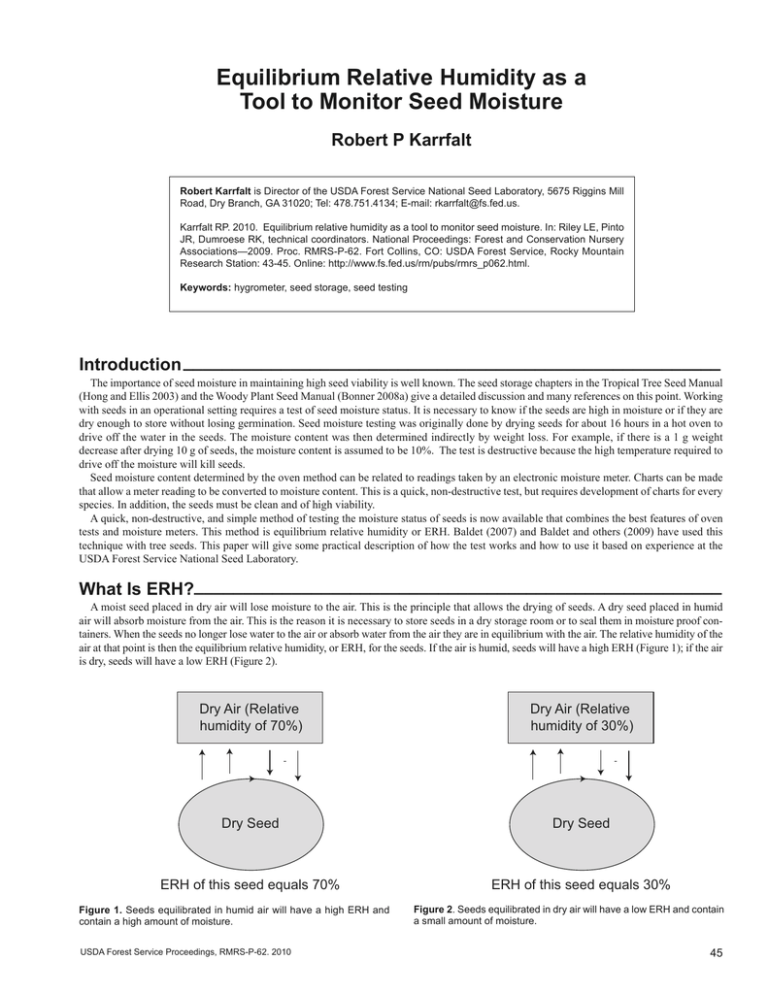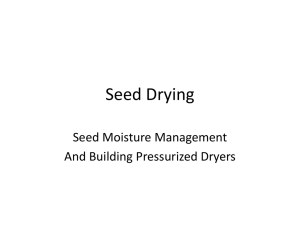Equilibrium Relative Humidity as a Tool to Monitor Seed Moisture
advertisement

Equilibrium Relative Humidity as a Tool to Monitor Seed Moisture Robert P Karrfalt Robert Karrfalt is Director of the USDA Forest Service National Seed Laboratory, 5675 Riggins Mill Road, Dry Branch, GA 31020; Tel: 478.751.4134; E-mail: rkarrfalt@fs.fed.us. Karrfalt RP. 2010. Equilibrium relative humidity as a tool to monitor seed moisture. In: Riley LE, Pinto JR, Dumroese RK, technical coordinators. National Proceedings: Forest and Conservation Nursery Associations—2009. Proc. RMRS-P-62. Fort Collins, CO: USDA Forest Service, Rocky Mountain Research Station: 43-45. Online: http://www.fs.fed.us/rm/pubs/rmrs_p062.html. Keywords: hygrometer, seed storage, seed testing Introduction _______________________________________________________ The importance of seed moisture in maintaining high seed viability is well known. The seed storage chapters in the Tropical Tree Seed Manual (Hong and Ellis 2003) and the Woody Plant Seed Manual (Bonner 2008a) give a detailed discussion and many references on this point. Working with seeds in an operational setting requires a test of seed moisture status. It is necessary to know if the seeds are high in moisture or if they are dry enough to store without losing germination. Seed moisture testing was originally done by drying seeds for about 16 hours in a hot oven to drive off the water in the seeds. The moisture content was then determined indirectly by weight loss. For example, if there is a 1 g weight decrease after drying 10 g of seeds, the moisture content is assumed to be 10%. The test is destructive because the high temperature required to drive off the moisture will kill seeds. Seed moisture content determined by the oven method can be related to readings taken by an electronic moisture meter. Charts can be made that allow a meter reading to be converted to moisture content. This is a quick, non-destructive test, but requires development of charts for every species. In addition, the seeds must be clean and of high viability. A quick, non-destructive, and simple method of testing the moisture status of seeds is now available that combines the best features of oven tests and moisture meters. This method is equilibrium relative humidity or ERH. Baldet (2007) and Baldet and others (2009) have used this technique with tree seeds. This paper will give some practical description of how the test works and how to use it based on experience at the USDA Forest Service National Seed Laboratory. What Is ERH?______________________________________________________ A moist seed placed in dry air will lose moisture to the air. This is the principle that allows the drying of seeds. A dry seed placed in humid air will absorb moisture from the air. This is the reason it is necessary to store seeds in a dry storage room or to seal them in moisture proof containers. When the seeds no longer lose water to the air or absorb water from the air they are in equilibrium with the air. The relative humidity of the air at that point is then the equilibrium relative humidity, or ERH, for the seeds. If the air is humid, seeds will have a high ERH (Figure 1); if the air is dry, seeds will have a low ERH (Figure 2). Dry Air (Relative humidity of 70%) Dry Air (Relative humidity of 30%) Dry Seed Dry Seed ERH of this seed equals 70% ERH of this seed equals 30% Figure 1. Seeds equilibrated in humid air will have a high ERH and contain a high amount of moisture. USDA Forest Service Proceedings, RMRS-P-62. 2010 Figure 2. Seeds equilibrated in dry air will have a low ERH and contain a small amount of moisture. 45 Karrfalt Equilibrium Relative Humidity as a Tool to Monitor Seed Moisture How Is ERH Measured?____________ ERH is measured with any reliable hygrometer, an instrument to measure relative humidity of the air, for which the sensor can be isolated in a closed area with an appropriate amount of seeds. A reliable hygrometer would be one that is known to give true readings. Most manufacturers supply salt solutions that are used to calibrate the hygrometer in the field to be sure it is giving true readings. For more accuracy, the solutions can be traced back to official standards and come with a certificate verifying their accuracy. Specialized hygrometers, called water activity meters, are more expensive but offer some advantage to working with small samples of seeds because they have a small chamber in which to place seeds. Water activity is actually a more complicated measurement than ERH, but as long as the seeds and the meter are at the same temperature, ERH and water activity are the same. An example of a water activity meter is shown in Figure 3. Water activity meters have some automated features that are helpful in taking the reading and work somewhat easier with smaller seeds or larger individual seeds. The hygrometer gives readings that are identical to those from the water activity meter. Figure 4. Measuring the ERH of sagebrush seeds by placing the hygrometer (Rotronic Instruments USA, Huntington, NY) entirely inside a plastic box containing the seeds. Figure 3. A water activity meter made by Decagon Devices Incorporated (Pullman, WA). Figure 5. A 2-L (0.5-gal) plastic drink bottle converted to a chamber to measure ERH with a hygrometer. To measure ERH with an inexpensive hygrometer, it is necessary to improvise a test chamber. If there are many seeds, they can be placed in a container such as the plastic box shown in Figure 4. The whole meter is placed in the container with the seeds. It is important that the probe does not touch the seeds or the container. If it does touch the container, a small static electricity charge can upset the hygrometer reading. A second approach is to take a small tube or discarded drink bottle to make a chamber (Figure 5). When using a tube or bottle, use a small strip of plastic foam to seal the probe in the neck of the tube or bottle. This keeps outside air from entering the test chamber. To use a drink bottle for the test chamber, squarely cut off the bottom. The bottom is then inverted and a cap used to seal the end of the test chamber. full saturation, the ERH again increases sharply. Relating ERH to moisture content is important from the standpoint that most existing seed storage research has been done using the moisture content principle. Research has shown that green (Fraxinus pennsylvanica) and European ash (F. excelsior) seeds at 8% moisture content would store for 7 years without losing viability (Bonner 2008b). Our chart shows that 30% ERH equates to a moisture content below 8%. The general rule of storing seeds at 30% ERH is, therefore, a good practice. For example, Wyoming big sagebrush (Artemisia tridentata var. wyomingensis), stored in sealed poly or foil laminate bags, maintained viability for an extended period if first dried to an ERH of 30% or 40% (Karrfalt and Vankus 2009) (Figure 7). Seeds that must be kept moist to maintain viability would require the ERH to be high. Samples of northern red oak (Quercus rubra) were tested for ERH as they were dried. An ERH of 80% equated to a moisture content below 25%, that is, the minimum moisture content needed for seeds to remain viable (Figure 8). How Is ERH Used?________________ Most temperate zone seeds are stored dry. They would be ready for storage when they have an ERH of 30% to 40%. Figure 6 shows how ERH changes as the moisture content of the seeds increases. Between 3% and 6% moisture content, the ERH increases sharply; between 6% and 10% moisture content, ERH increases slowly; and from 10% to 46 USDA Forest Service Proceedings, RMRS-P-62. 2010 Equilibrium Relative Humidity as a Tool to Monitor Seed Moisture Karrfalt Moisture Content vs Equilibrium mc Relative Humidity 35.00 Poly. (mc) ERH is a very simple and accurate method for monitoring seed moisture. It has the following benefits: 30.00 Seed Moisture Content Conclusion ______________________ 20.00 • It can be used on any seed lot regardless of viability, purity, stage of extraction, or species. Seeds of grasses, forbs, shrubs, and trees can all be tested with ERH. Most research to date suggests that 30% ERH will be a good target for storing seeds. 15.00 • No conversion charts are needed. Therefore, any species can be tested. y = 85.294x3 - 99.113x2 + 43.567x R² = 0.9779 25.00 • Traceable standards are available for calibrating the hygrometer, providing excellent ways to maintain high quality control for very accurate measurements. 10.00 5.00 0.00 • The test is non-destructive. Valuable seeds or very small lots can be tested directly with no loss of material. 0 0.1 0.2 0.3 0.4 0.5 0.6 0.7 Equilibrium Relative Humidity 0.8 0.9 1 Figure 6. ERH of green ash (Fraxinus pennsylvanica) plotted against moisture content. • ERH is a fast test; results are obtained in a few minutes. • The test is very easy to use. • Equipment costs are relative low, between US$ 200 to 2500. A proper set of equipment for oven moisture testing would be twice as expensive. References ______________________ Figure 7. Germination of Wyoming big sagebrush (Artemisia tridentata var. wyomingensis) stored at different ERH and storage temperatures. Red Oak Isotherm 35 y = 0.0003x3 - 0.0552x2 + 3.5408x - 66.966 R² = 0.8604 30 Moisture Content % Baldet P. 2007. From deep frozen pizza … to forest seeds and pollens. Info Medias Number 82 October 2008. URL: http://www.cemagref.fr/Informations/Presse/InfMediaEV/infomedia82EV/im82PollensEV.htm (accessed 21 Feb 2010). Baldet P, Colas F, Bettez M. 2009. Water activity—an efficient tool for seed testing. Canadian Forest Genetics Association Tree Seed Working Group News Bulletin Number 50 December 2009. URL:http://www.for.gov.bc.ca/ hti/publications/tswg/TSWGNewsbulletin50.pdf (accessed 21 Feb 2010). Bonner FT. 2008a. Storage of seeds. In: Bonner FT and Karrfalt RP, editors. The woody plant seed manual. Washington (DC): USDA Forest Service. Agriculture Handbook 727. p 85-95. Bonner FT. 2008b. Fraxinus. In: Bonner FT and Karrfalt RP, editors. The woody plant seed manual. Washington (DC): USDA Forest Service. Agriculture Handbook 727. p 537-543. Hong TD, Ellis RH. 2003. Storage. In: Vozzo JA, editor. Tropical tree seed manual. Washington (DC): USDA Forest Service. URL: http://www.rngr.net/ publications/ttsm (accessed 21 Feb 2010). Karrfalt RP, Vankus VG. 2009. 2008 annual report Great Basin Native Plant Selection and Increase Project. URL: http://www.fs.fed.us/rm/boise/ research/shrub/projects/documents/2008_Progress_Report.pdf (accessed 21 Feb 2010). 25 20 Dead seeds on this side of 80% ERH 15 Live seeds on this side of 80% ERH 10 5 0 40 50 60 70 80 90 100 Figure 8. ERH of northern red oak (Quercus rubra) plotted against moisture content. The content of this paper reflects the views of the authors, who are responsible for the facts and accuracy of the information presented within. USDA Forest Service Proceedings, RMRS-P-62. 2010 47







